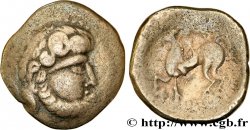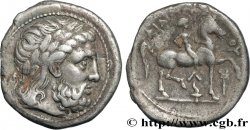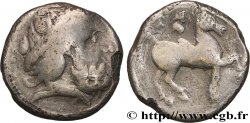bga_177705 - DANUBIAN CELTS - TETRADRACHMS IMITATIONS OF PHILIP II AND HIS SUCCESSORS Tétradrachme “au monogramme d’Audoléon”
недоступный.
Товар уже продан в нашем интернет-магазине
Цена: : 750.00 €
Товар уже продан в нашем интернет-магазине
Цена: : 750.00 €
Тип Tétradrachme “au monogramme d’Audoléon”
Дата: c. IIe-Ier siècles AC.
Металл: silver
Диаметр: 23,7 mm
Ориентация осей монеты: 8 h.
Вес: 13,2 g.
Редкость: R2
Комментарии о состоянии
Très beau portrait sur un flan relativement large. Revers stylisé. Frappe un tout petit peu faible sur la partie supérieure du cavalier au revers. Jolie patine de médaillier, avec une légère rayure à 12h au revers et sur la queue du cheval
Лицевая сторона
Аверс: легенда: ANÉPIGRAPHE.
Аверс: описание: Tête barbare, laurée et barbue de Zeus à droite.
Обратная сторона
Реверс: легенда: ANÉPIGRAPHE.
Реверс: Описание: Cavalier très stylisé, sur un cheval plus réaliste ; une volute devant le poitrail, une esse bouletée sous la jambe gauche du cheval et un fleuron sous le ventre.
Комментарий
Sur ce type, la couronne de laurier est très importante d'où l'appellation de "Verkehrten Lorbeerkranz". Elle est de plus perlée aux extrémités, visible sur notre exemplaire au-dessus du front. Au revers, outre le monogramme, nous avons deux symboles énigmatiques, l'esse bouletée entre les antérieurs du cheval et la volute devant le poitrail.








 Cообщить об ошибке
Cообщить об ошибке Распечатать страницу
Распечатать страницу Отправить мой выбор
Отправить мой выбор Задать вопрос
Задать вопрос Consign / sell
Consign / sell
 Информация
Информация









